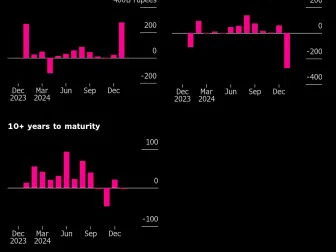January 28, 2025

(Bloomberg) -- Follow Bloomberg India on WhatsApp for exclusive content and analysis on what billionaires, businesses and markets are doing. Sign up here .
It’s not just stocks — foreign investors in one of the best-performing emerging bond markets are showing signs of wariness.
Global funds bought just 26.4 billion rupees ($305 million) of notes eligible for inclusion into JPMorgan Chase & Co.’s flagship developing-market debt index so far this year, data compiled by Clearing Corp. of India Ltd. show. That’s set to make January’s inflows among the smallest since the bank announced India’s entry into the global fixed-income gauge 16 months ago.
Surging US Treasury yields and a slumping rupee have prompted bond funds to proceed with caution. Wall Street lenders like Morgan Stanley have dialed down forecasts for inflows into these securities, just as they’re set to join Bloomberg’s gauge for emerging markets by month-end.
Bloomberg LP is the parent company of Bloomberg Index Services Ltd., which administers indexes that compete with those from other service providers.“I have more of a neutral view” now on India’s 10-year bond yields given the currency risk, after being bullish a few months ago, said Carlos Carranza, a portfolio manager at Allianz Global Investors in London. “For bonds to look a lot more appealing, to be offering a lot more value, you would need to see a slowdown in the devaluation of the currency.”
It wasn’t supposed to be this way. India’s entry into JPMorgan’s flagship index in June was billed as a milestone for the $1.3 trillion sovereign debt market. Investor sentiment for local assets, however, has been shaped by wagers on interest rate policies in both India and the US.
When Federal Reserve Chair Jerome Powell signaled in April at a longer-than-expected wait for rate cuts, global funds pulled money from shorter-dated Indian bonds, data compiled by Bloomberg show. In contrast, once the Fed began its cutting rates, the bulk of the outflows shifted to longer-term notes.
Since India’s inclusion, investors have put 712 billion rupees ($8.2 billion) into index-eligible bonds. JPMorgan had estimated $20 billion to $25 billion of inflows over a 10-month period starting in June. Almost $11 billion flowed between September 2023 — when the US bank announced the nation’s entry — and June 2024. This early surge likely left less room for sustained momentum in the second half.
Still, India’s debt market journey is just beginning. By year-end, the nation will be part of all major EM bond gauges. It is set to be added to Bloomberg’s emerging-market index this month, and by the end of March, will reach its full 10% weighting in JPMorgan’s benchmark. Membership in FTSE Russell’s gauge is also slated for later this year.
Overall, foreign investors shifted a greater proportion of funds into longer-dated securities in the course of 2024, betting on eventual rate cuts by the Reserve Bank of India. While those rate cuts have yet to materialize, the share of funds invested in debt maturing in 10 years or more has risen steadily.
Despite the current market trough, investors, including Stefanie Holtze-Jen, Deutsche Bank AG’s chief investment officer for Asia Pacific, view this as an opportunity to buy because India’s long-term prospects remain attractive.
“It doesn’t detract from the overall investment opportunity that we see that is structurally there,” she said.
Global Funds Rethink India Promise as $2 Trillion Rally Stumbles
Structural Slowdown Makes India a Sell, UBS’s Narain Says
India Finance Is on the Brink of Its Breakout Moment: QuickTake
--With assistance from Shadab Nazmi, Bhaskar Dutta, Sandeep Junnarkar and Jin Wu.